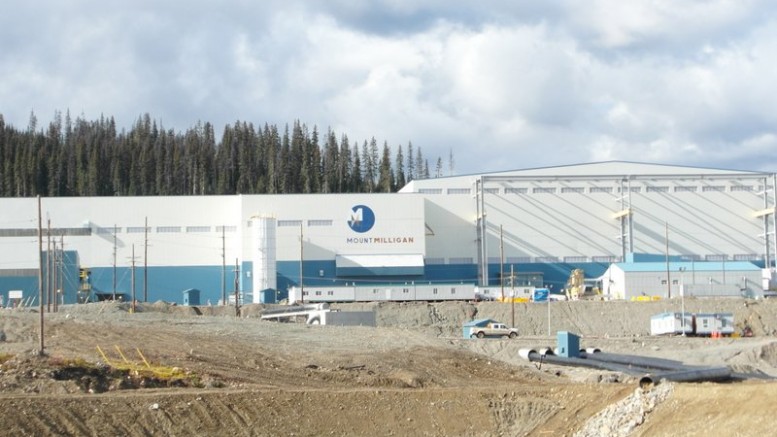PRINCE GEORGE, B.C. — Thirty years after prospector Richard Hanslinger discovered copper-gold mineralization in the hills north of Fort St. James in central B.C. and three years after Thompson Creek Metals (TSX: TCM; NYSE: TC) struck a $650-million deal for the company that turned the discovery into a development-ready deposit, the Mt. Milligan copper-gold mine is in production.
Located 155 km northwest of Prince George, B.C., the mine started crushing rock in August, produced its first copper-gold concentrate in September and expects to operate at capacity by year-end.
On Oct. 8 Hanslinger was on-site to celebrate that achievement, alongside many others who helped bring the $1.6-billion mine to life: Thompson Creek’s management team, provincial and local politicians, local First Nations chiefs, representatives from a raft of contractors and suppliers, and reps from Royal Gold (TSX: RGL, NASDAQ: RGLD), the streaming company that put $782 million into Mt. Milligan for the right to buy half of the mine’s gold.
“When we came here in 2010 to do the deal with Terrane there was nothing here, no sign of any of this,” said Kevin Loughrey, who stepped down as chairman and CEO of Thompson Creek less than a week after the Mt. Milligan event. “Now here we are, three and a half years later, and we have a mine and a mill, and a world-class facility.”
Thompson Creek built Mt. Milligan quickly for one reason: by the time the company bought Terrane Metals to get its hand on the large copper-gold project, Terrane had already done almost all of the planning and permitting grunt work. Former Terrane president and CEO Rob Pease was on hand to mark the event, and Loughrey made sure to pay him credit.
“Many of the things that have happened here and that people have complimented us on in the development of Mt. Milligan are the result of the work of Rob and his team,” Loughrey said. “They put together a reasonable footprint and a no-discharge facility, and a plan to move a lot of dirt and still produce copper and gold efficiently and profitably. And on top of all that Rob is a decent, honourable and enjoyable guy to work with. So for all of that: thank you, Rob.”
Mt. Milligan is B.C.’s first greenfield mine in 15 years. It is expected to produce 81 million lb. copper and 195,000 oz. gold annually over a 22-year mine life. At the peak of construction there were more than 1,000 people at work on the site. During regular operations it will employ 400 people.
With achievements like that, the Mt. Milligan opening event attracted not one but three B.C. Members of the Legislative Assembly: local riding representative Mike Morris, Minister of Energy and Mines Bill Bennett and Minister of Jobs, Tourism and Skills Training Shirley Bond.
“I know that Thompson Creek is concentrating on community and regional sustainability,” Bond said. “Do you know that the value of business conducted with local businesses in 2012 was $125 million? Do you know that more than 60% of the operations personnel hired came from the local region? Those things are so critical when we’re talking about the direct and indirect benefits of a project like this.”
Loughrey, an American lawyer who has worked worldwide in the mining sector for decades, sent accolades back towards the politicians.
“I have really come to admire the way Canadians tend to deal with these issues,” Loughrey said, referring to how elected representatives and companies like Thompson Creek negotiate their way around development-related conflicts. “I have done a lot of work in a lot of countries, and in Canada these people work tremendously hard on behalf of their constituents, but at the same time work efficiently, profitably and reasonably with the companies that are trying to do things in their area, and that combination of traits allows things like Mt. Milligan to happen.”
Loughrey also paid credit to Fluor (NYSE: FLR) and AMEC, the two firms that managed the engineering, procurement and construction of Mt. Milligan, as well as Royal Gold, which provided half of the $1.5 billion needed to build the mine.
“Only one thing stood between us and acquiring Terrane, and that was money,” Loughrey said, smiling. “We were just a tad short. Then Tony Jensen stood up — he’s the president of Royal Gold — and we’ve done several deals since, and it has been a huge part of financing Mt. Milligan. I can honestly say that Tony is the only man here who is as interested in the success of Mt. Milligan as I am.”
By putting $782 million into the mine, Royal Gold secured the right to buy 52% of the gold produced at Mt. Milligan for the lesser of US$435 per oz., or the prevailing price of gold. Since the mine is expected to produce some 4.3 million oz. gold over the next two decades, as soon as it entered production Mt. Milligan became a cornerstone property for Royal Gold, which collects precious-metal royalties and streams from dozens of operating mines.
The mine has become Thompson Creek’s flagship operation. Thompson Creek produces molybdenum at its namesake mine in Idaho and its 75%-owned Endako mine in northern B.C., while processing moly at its metallurgical facility in Pennsylvania. Mt. Milligan is the company’s first significant foray outside of the molybdenum world and is far larger than the company’s other operations.
“This means everything for our company,” Loughrey said. “We had been a molybdenum company, and that’s a great thing when molybdenum is selling for US$35 per lb. When it’s selling for US$9.25 per lb. — not so great. We knew that was a problem for us, so we started looking to diversify.”
Mission accomplished.


Be the first to comment on "Thompson Creek all smiles at Mount Milligan"